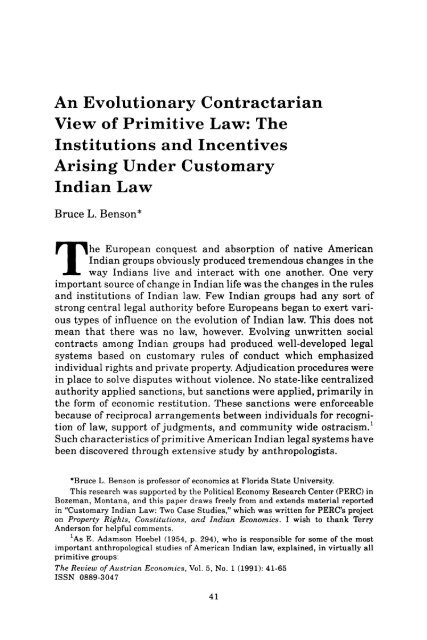Review of Austrian Economics - The Ludwig von Mises Institute
Review of Austrian Economics - The Ludwig von Mises Institute
Review of Austrian Economics - The Ludwig von Mises Institute
You also want an ePaper? Increase the reach of your titles
YUMPU automatically turns print PDFs into web optimized ePapers that Google loves.
An Evolutionary Contractarian<br />
View <strong>of</strong> Primitive Law: <strong>The</strong><br />
Institutions and Incentives<br />
Arising Under Customary<br />
Indian Law<br />
Bruce L. Benson*<br />
<strong>The</strong> European conquest and absorption <strong>of</strong> native American<br />
Indian groups obviously produced tremendous changes in the<br />
way Indians live and interact with one another. One very<br />
important source <strong>of</strong> change in Indian life was the changes in the rules<br />
and institutions <strong>of</strong> Indian law. Few Indian groups had any sort <strong>of</strong><br />
strong central legal authority before Europeans began to exert various<br />
types <strong>of</strong> influence on the evolution <strong>of</strong> Indian law. This does not<br />
mean that there was no law, however. Evolving unwritten social<br />
contracts among Indian groups had produced well-developed legal<br />
systems based on customary rules <strong>of</strong> conduct which emphasized<br />
individual rights and private property. Adjudication procedures were<br />
in place to solve disputes without violence. No state-like centralized<br />
authority applied sanctions, but sanctions were applied, primarily in<br />
the form <strong>of</strong> economic restitution. <strong>The</strong>se sanctions were enforceable<br />
because <strong>of</strong> reciprocal arrangements between individuals for recognition<br />
<strong>of</strong> law, support <strong>of</strong> judgments, and community wide ostracism. 1<br />
Such characteristics <strong>of</strong> primitive American Indian legal systems have<br />
been discovered through extensive study by anthropologists.<br />
*Bruce L. Benson is pr<strong>of</strong>essor <strong>of</strong> economics at Florida State University.<br />
This research was supported by the Political Economy Research Center (PERC) in<br />
Bozeman, Montana, and this paper draws freely from and extends material reported<br />
in "Customary Indian Law: Two Case Studies," which was written for PERC's project<br />
on Property Rights, Constitutions, and Indian <strong>Economics</strong>. I wish to thank Terry<br />
Anderson for helpful comments.<br />
As E. Adamson Hoebel (1954, p. 294), who is responsible for some <strong>of</strong> the most<br />
important anthropological studies <strong>of</strong> American Indian law, explained, in virtually all<br />
primitive groups:<br />
<strong>The</strong> <strong>Review</strong> <strong>of</strong> <strong>Austrian</strong> <strong>Economics</strong>, Vol. 5, No. 1 (1991): 41-65<br />
ISSN 0889-3047<br />
41

















